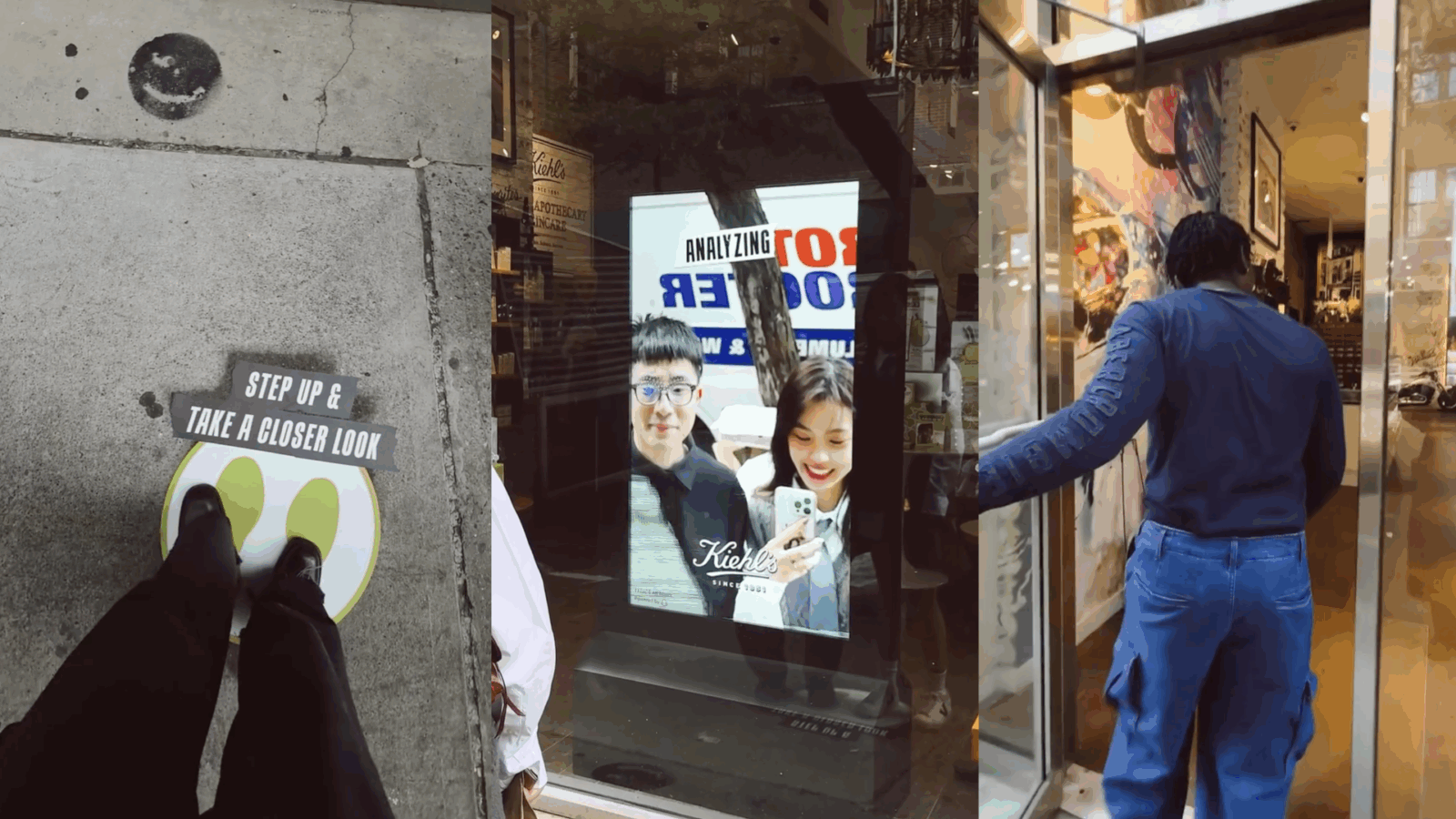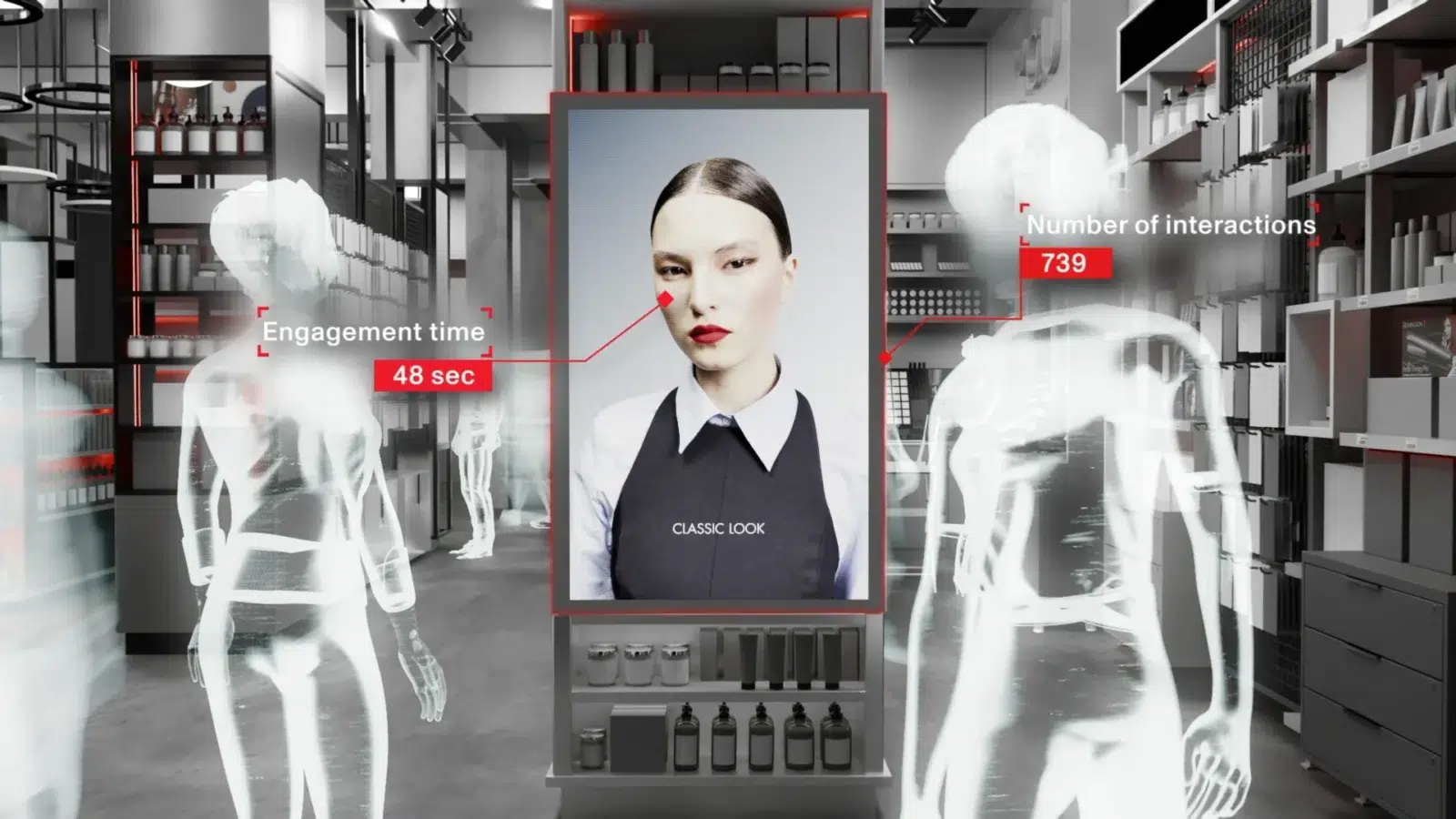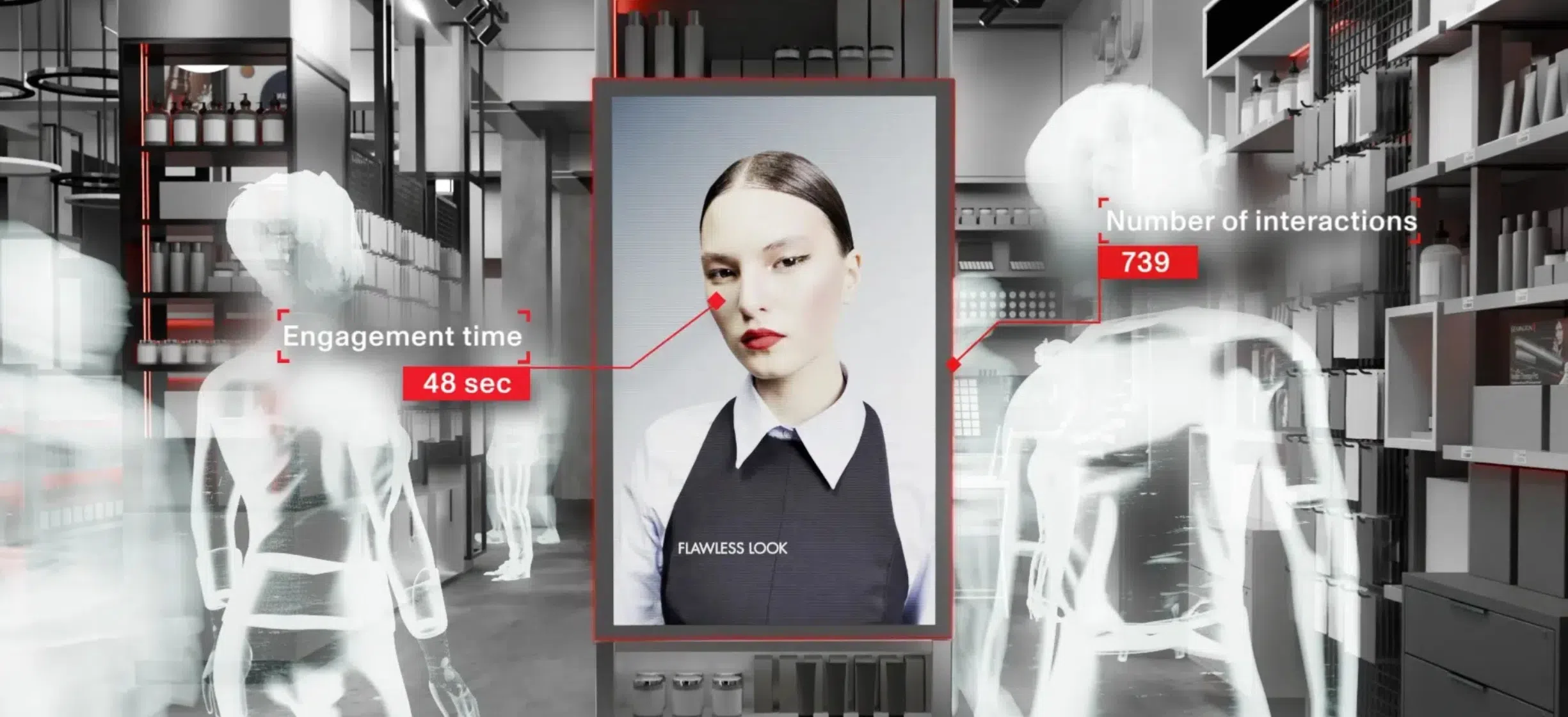TL;DR
AI is transforming Out-of-Home advertising from a static awareness channel into a measurable, real-time performance medium. As digital ads face declining effectiveness and consumers crave real-world brand experiences, physical media is gaining renewed value — but now enhanced with AI-driven targeting, dynamic content, and privacy-safe audience analytics. Modern OOH can predict where audiences will be, adapt creative to context, verify attention, and link exposure to store visits and sales. Platforms like LOOOK.AI take this further by turning screens and smart mirrors into interactive, insight-rich touchpoints that blend digital precision with physical presence. The result: OOH becomes a scalable, accountable growth channel that delivers emotional impact and proven ROI — not just reach, but measurable business outcomes.
Why AI-Powered OOH Is Becoming Essential for Modern Marketing
The advertising industry is changing because of shifts in how people behave, new technology, and how media dollars are spent. Digital advertising alone is becoming less effective. Privacy laws have made it harder to target specific audiences, more people are using ad blockers, and consumers are ignoring online ads because they see too many of them. Meanwhile, brands are realizing that physical spaces matter more than ever. Real-world locations, hands-on experiences, and in-person interactions are becoming important again, especially after the pandemic. Out-of-Home advertising has become one of the fastest-growing ad channels because it reaches people in the right context and creates memorable brand moments that are hard to miss.
At the same time, marketing teams are being held to stricter performance standards. They need to measure results, optimize campaigns, and prove ROI across every channel—including physical advertising. This need has driven the growth of AI-powered OOH solutions. These tools provide detailed audience data, adjust content automatically, and connect offline ads to real business results. They close the gap between traditional brand advertising and modern performance marketing that relies on data and accountability.
“Audiences developed banner blindness online, and now we see the same effect in physical spaces. Traditional visuals no longer stop people—experiences do. That’s why OOH needs to evolve from static surfaces to interactive, measurable touchpoints powered by AI.” — Dmytro Kornilov, CEO, LOOOK.AI
This shift means AI-driven billboards are no longer just an old medium trying to stay relevant. Instead, it is becoming a core part of future marketing strategies that connect multiple channels. It helps brands break through the noise and build real connections with people in the physical world.

What AI Brings to OOH
Artificial Intelligence is changing Out-of-Home advertising by giving physical media the ability to respond, adapt, and track results in ways that were not possible before. Rather than showing the same message to everyone, AI-powered OOH becomes a channel that adjusts in real time based on data and insights. It delivers the accuracy and measurement capabilities of digital marketing while keeping the emotional impact and broad reach that only physical advertising can provide.
| AI Capability | Business Value |
|---|---|
| Dynamic content personalization | Higher relevance & consumer responsiveness |
| Computer-vision analytics | Accurate, privacy-safe real-world measurement |
| Predictive planning | Better media efficiency & audience targeting |
| Real-time optimization | Continuous performance improvement |
| Attribution modeling | Clear ROI tied to foot traffic & sales |
| Generative creative | Fast, scalable, cost-efficient production |
Dynamic Content & Contextual Intelligence
AI gives screens the ability to respond to what’s happening around them. Campaigns can change automatically based on the time of day, who’s walking by, the weather, local events, and even current product availability. Instead of showing the same message to everyone, brands can deliver content that fits the moment and location. This makes the message more relevant and increases the chance that people will respond. Essentially, every screen becomes a smart surface that constantly adjusts its message based on what’s happening in real time.
Computer Vision & Attention Intelligence
Computer vision technology improves how we measure OOH performance. Instead of guessing how many people saw an ad, cameras can now track real engagement. They measure how many people stopped, how long they looked, and where their eyes went—all without collecting personal information. This gives brands accurate data about who actually noticed and engaged with their message. It’s a major change from old methods that just estimated impressions. LOOOK.AI use this technology in interactive displays and smart mirrors, so brands can measure real impact instead of making assumptions.
Predictive Media Decisioning
AI makes media planning smarter by studying how people move, which locations perform best, and what has worked in the past. Brands can predict where their audience will be, how they’ll travel through spaces, and which locations will have the most influence. This shifts physical media from fixed schedules to strategic placement. Instead of reacting after the fact, OOH networks can plan ahead and position screens where they’ll be most effective. AI turns every screen into part of a constantly improving media strategy.
Attribution and Commercial Accountability
One of the biggest benefits of AI is connecting physical advertising to real business results. Brands can now see how OOH drives store visits, product interactions, online searches, and purchases. The channel changes from being just a brand awareness tool to a measurable driver of growth, with clear performance metrics. AI brings the kind of financial clarity to OOH that executives need, solving a long-standing challenge in proving direct return on investment.

Kiehl’s AR storefront activation delivered a 20% increase in foot traffic.
Automated Creative Intelligence
Generative AI makes creating and updating content faster and easier. Instead of waiting months to produce new campaigns, brands can now update messaging, formats, and visuals in real time based on what’s working. They can quickly create versions for different locations, adapt designs for various markets, and keep content fresh without extra work. Creative production becomes flexible and responsive, allowing OOH to operate with the same speed and adaptability as digital channels.
A New Intelligent Media Standard
AI turns OOH into a smart system that engages people in the right context, understands real-world behavior, and proves its business value at scale. With solutions like LOOOK.AI, screens become interactive intelligence points that combine visual impact with real-time data and engaging experiences. This creates a new standard for physical media—one where technology doesn’t just display content, but actively senses, learns, and influences consumer behavior.
How AI-Powered OOH Delivers Real Business Results
Instead of using fixed placements and unchanging creative, brands can now manage physical media with the same level of control, measurement, and continuous improvement they expect from digital marketing. This means OOH not only reaches people in important physical locations, but also demonstrates a clear connection between ad exposure and actual consumer actions and sales. For marketing leaders, this change makes AI-powered OOH a valuable business tool that gets more value from physical advertising spaces while building brand strength and delivering results that can be tracked and verified.
- Improved media efficiency: AI optimizes screen selection, timing, and placement to reach engaged audiences, reducing waste and maximizing ROI through smart targeting and continuous optimization.
- Measurable brand performance: Computer vision tracks real attention and attribution systems connect OOH to store visits and sales, transforming physical advertising into a proven performance channel with concrete metrics.
- Enhanced consumer engagement: Interactive features like AR, gesture control, and smart mirrors create memorable brand experiences that drive longer engagement and social sharing.
- Competitive differentiation: AI-powered OOH demonstrates innovation and captures attention through dynamic formats that create unique physical brand experiences impossible to replicate online.

What AI Technology Is Used in Out-of-Home Advertising?
AI transforms Out-of-Home advertising by adding smart technology that makes physical screens work like digital marketing channels, helping brands plan better, measure accurately, and create relevant content.
Computer Vision & Privacy-Safe Analytics
Computer vision tracks real engagement—how many people stop, how long they look, and where they focus—without collecting personal information. This provides accurate data while staying compliant with privacy laws like GDPR and CCPA.
Edge AI for Real-Time Media Decisions
Edge AI runs directly on screens, enabling instant content changes based on who’s nearby or how people interact. Smart mirrors and gesture-controlled displays respond in real time, making OOH more responsive across large networks.
CMS & Remote Content Management
Cloud-based content management systems let brands control all screens from one location, enabling instant updates, A/B testing, regional customization, and scheduling while maintaining consistency across locations.
Generative AI Creative Engines
Generative AI helps brands create and update content rapidly, adapting messaging for different audiences, times, or products with minimal effort. This reduces production time and costs while keeping content fresh and relevant.
Cloud Dashboards for Performance Insights
Centralized dashboards consolidate attention metrics, engagement rates, foot traffic, and campaign performance in one view. LOOOK.AI track detailed interactions across all locations, helping executives make better budget and strategy decisions.

The technology powering LOOOK.AI platform.
How Does AI Make OOH Advertising More Cost-Effective and Scalable?
AI-driven OOH reduces costs and improves operations by automating creative work, choosing better ad placements, and making screens more productive across networks. Brands can now create many versions of their ads at little extra cost. Instead of producing fixed campaigns, they can build flexible content that adapts to different audiences and situations. Updates and new experiences can be pushed to all locations remotely, which saves time and reduces the need for on-site staff. AI also makes sure marketing budgets go to the places where people actually pay attention, cutting waste and improving efficiency. The outcome is a channel that shows clear return on investment instead of estimated reach. It also extends the value of OOH infrastructure by turning screens from static displays into tools that continuously learn and drive business growth.
How to Implement AI-Powered OOH: Step-by-Step Guide
Deploying AI-powered OOH doesn’t require replacing your entire media infrastructure overnight. Instead, it’s a phased approach that starts with strategic assessment, moves through testing and validation, and scales based on proven results. Here’s how leading brands are implementing intelligent physical media:
- Audit Your Physical Footprint: Review your physical locations, customer touchpoints, and high-traffic areas to identify where intelligent media will deliver the most business value.
- Select Technology Partners: Choose platforms and technology partners that provide AI-powered targeting, measurement, and content management capabilities.
- Set Up Analytics and Tracking: Establish clear analytics and tracking systems from the start so performance can be monitored in real time.
- Launch Pilot Programs: Begin with pilot programs in key locations to test the technology and measure engagement and foot traffic results.
- Measure and Optimize: Analyze the performance data from your pilots and optimize your approach based on what works best.
- Scale Across Locations: Expand successful pilots to more regions and formats, gradually building out your AI-powered OOH network.
- Integrate with Marketing Systems: Connect OOH data to existing marketing dashboards so teams can view all channels in one unified platform.
- Ensure Privacy Compliance: Implement strong data privacy policies and compliance measures to protect consumers and meet legal requirements throughout the process.
Conclusion
AI is changing the role of Out-of-Home media. It’s no longer just a tool for building brand awareness—it’s now an intelligent, measurable marketing channel that drives real business results. AI brings real-time decision-making, privacy-safe audience tracking, flexible creative content, and the ability to connect ads to actual customer actions. This gives OOH the precision and accountability that digital marketing has, while keeping the emotional impact and physical presence that only real-world advertising can provide. As people seek more engaging experiences and brands need proof of performance, AI-powered OOH is not a future possibility—it’s a current advantage. LOOOK.AI make this shift easier by helping companies deploy interactive, data-driven media at scale. Every screen becomes a measurable tool for capturing attention, driving engagement, and growing the business.







